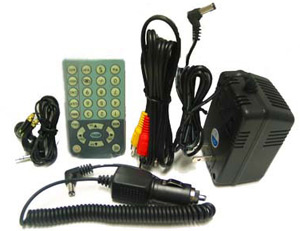![[SoundStage!]](../titles/sslogo3.gif) Home
Audio Home
Audio Equipment Review |
||||
One of the greatest nuisances for a two-channel audiophile lucky enough to use a universal audio/video player like the Esoteric DV-50 that I recently reviewed has nothing to do with sound. A universal player by definition is a complex component that's designed to play both audio and video software. So while you can connect it to a two-channel system and use it purely for stereo music playback, at some point you'll need access to the player's onscreen menus -- for adjusting everything from the digital output to how the player handles the various types of software it will encounter. DVD-As also pose a video challenge, as many of them have onscreen menus that allow you to pick which audio track you want to hear or require other maneuvering. Often I can simply push enter and a DVD-A will play, but I'm never sure if I'm hearing the high-rez two-channel mix or a downmixed multichannel one. Oh bother. If you're like me and have a stereo-only system (no stinkin' TV between my speakers), getting video from your A/V player involves disconnecting the player from your audio system, lugging it upstairs to where your TV is, connecting its video output to the TV, making the adjustments needed, disconnecting it from the TV, lugging it downstairs, and reconnecting it to the audio system. The whole process takes only about 15 minutes, but the aggravation of having to do it, especially in light of the money I've spent on my audio system, makes having a hot new universal player something of a chore. One solution is to buy a small TV and connect it to the player permanently. In my mind, this undercuts the purist approach to two-channel audio as it makes for one more large component to be part of my system. Even a 13" TV is big and bulky, and finding a place for it is not easy. There are, of course, smaller TVs available now, but even a low-end LCD TV from Sharp or Samsung costs several hundred dollars, and you're still looking at screen sizes of at least 13". Internet vendor Merconnet has come to the rescue with the GMX HT-A777 7" color LCD monitor, which costs $229 USD and is small and light enough (7 7/8"W x 6 1/2"H x 2"D and 2 pounds) to rest comfortably on top of a player even as diminutive as the Sony DVP-NS500V. I use an inexpensive digital cable from the composite video output of the Esoteric DV-50 into the input on the HT-A777 -- no sound from the TV is needed in this application. The monitor sits nicely behind the player and turned off until I need to see the video on the disc or want to change a menu parameter. No more disconnecting, lugging, and reconnecting. Woo hoo!
If you're tired of disconnecting your universal audio/video player every time you want to change a menu setting or have begun to dread playing DVD-As because of their menus, the GMX monitor is a small-footprint way to alleviate these hassles, and it costs a pittance compared to what we audiophiles spend on all manner of performance-enhancing tweaks. I love this thing! ...Marc Mickelson
|
||||
|
||||
![[SoundStage!]](../titles/sslogo3.gif) All
Contents All
ContentsCopyright © 2003 SoundStage! All Rights Reserved |

 And while the GMX
HT-A777 works perfectly in this limited capacity, it has features that make it perfect for
other uses as well. It has a built-in TV tuner, so you can use it for watching TV while
you sit at your desk pounding out audio reviews. It comes with a DC converter, so you can
take it on the road (and perhaps pair it with Merconnet's NextBase2 portable DVD player).
It can be mounted in a variety of ways, and it comes with a credit-card-sized infrared
remote control. Image quality is good overall, not quite as crisp and saturated as that of
my Sony laptop playing DVDs, but it's certainly acceptable. Inputs are for mono audio
(even though there are two speakers on the front) and composite video. There's also an
input for an external antenna and a mono earphone output. The HT-A777's various setup
parameters are accessed via its own onscreen menus. The HT-A777 is not exactly feature
packed, but it offers enough functionality to satisfy the bulk of potential buyers -- and
more than enough for people like me who will use it for a few minutes here and there.
And while the GMX
HT-A777 works perfectly in this limited capacity, it has features that make it perfect for
other uses as well. It has a built-in TV tuner, so you can use it for watching TV while
you sit at your desk pounding out audio reviews. It comes with a DC converter, so you can
take it on the road (and perhaps pair it with Merconnet's NextBase2 portable DVD player).
It can be mounted in a variety of ways, and it comes with a credit-card-sized infrared
remote control. Image quality is good overall, not quite as crisp and saturated as that of
my Sony laptop playing DVDs, but it's certainly acceptable. Inputs are for mono audio
(even though there are two speakers on the front) and composite video. There's also an
input for an external antenna and a mono earphone output. The HT-A777's various setup
parameters are accessed via its own onscreen menus. The HT-A777 is not exactly feature
packed, but it offers enough functionality to satisfy the bulk of potential buyers -- and
more than enough for people like me who will use it for a few minutes here and there.